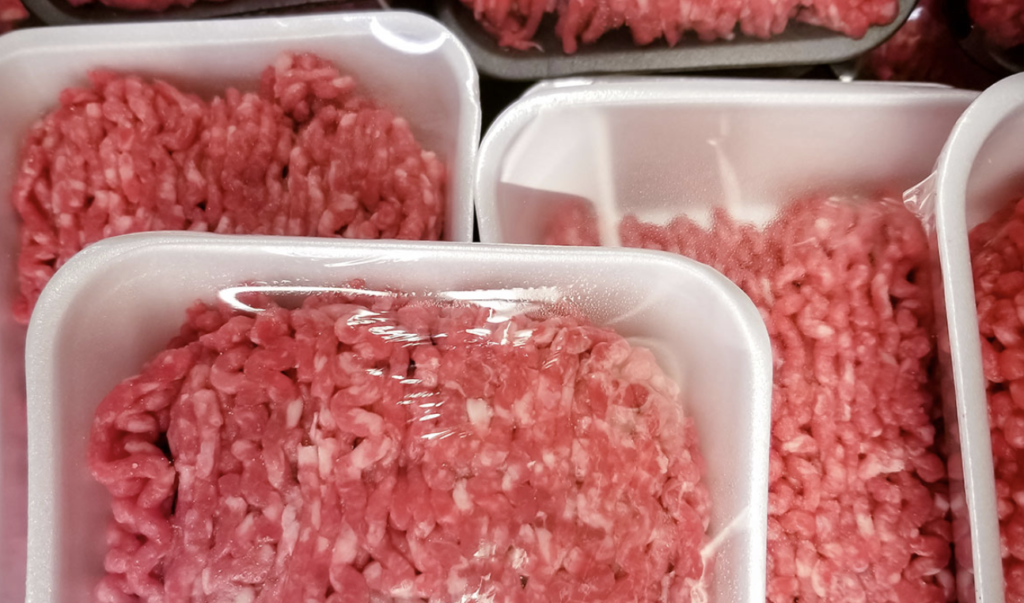You’ve probably noticed that packages of ground beef in your supermarket case have different names and prices, but do you really know what they mean? Here’s a quick guide to helping you buy the healthiest and tastiest choices of ground beef, rather than just shopping by price.

The Fat Content Varies
The main difference between ground beef types is the fat content. When buying whole beef cuts, the cheaper the cut, the less fat it has. The opposite is true when buying ground beef. The cheapest packages have the most fat.
Here’s a quick guideline showing the approximate lean-to-fat ratios of different types of ground beef:
•Lean Ground Beef – 95/5
•Ground Sirloin – 90/10
•Ground Round – 85/15
•Ground Chuck – 80/20
•Hamburger/Ground Beef – 73/27
Meat labeled as “hamburger” or “ground beef” can come from almost any part of the cow. Ask your butcher what the grind contains and if it has the chemical filler “pink slime.” You might even find that today, based on what the store needed to get rid of, the hamburger is made from filet or ribeye!
What’s Best for Burgers?
When you buy ground beef for making hamburgers, you might be tempted to buy the leanest choice. You’ll see on the label a percentage, such as “90% lean.” The problem with very lean ground beef is that the low-fat content makes it more dry. This is fine if you’ll be covering the beef with spaghetti sauce or using it in tacos that will be covered with lots of toppings.
If you want a juicy hamburger, however, your best bet will be ground chuck, an 80/20 grind. This is the mix many top restaurant chefs use for their high-end burgers.
Grass-fed, Organic Beef
In our blog post, Whole Foods & Organics: Worth the Cost?, we noted that not all natural fruits and vegetables are worth the high price. Organic beef, on the other hand, is a much healthier choice than commercially raised beef. This is because mass-produced beef often contains antibiotics, growth hormones and other chemicals.
These cows are also not grass-fed, and some of the commercial food they eat are grown or treated with commercial fertilizers and pesticides. In some cases, the food these cows eat includes the unusable parts of other cows that remain after their processing (cannibalism)! Organic, grass-fed beef also contains more heart-healthy Omega-3 fatty acids. Look for lean, natural, organic, grass-fed beef if you want the healthiest option for yourself or your family.
Choose Healthier Portion Sizes
When serving beef, you can reduce calories by using the meat to flavor dishes that feature plenty of other heart-healthy ingredients. For example, instead of a half-pound hamburger, make a smaller patty and dress it with thick slices of ripe tomatoes, caramelized onions, sautéed mushrooms, crunchy greens and just one slice of low-fat cheese.
Don’t Reduce the size of the bun without skimping on the quality of the bread – make the bread an important part of the flavor combination. Choose Flatout flatbreads or Foldits to make delicious burger wraps or sliders you pair with healthy side dishes or a bowl of low-fat vegetable soup.
Serve kids Sloppy Joe sliders (instead of large sandwiches) with baked sweet potato fries and a light Cole slaw. Turn a bowl of baked beans into a main course by adding some ground beef and flavoring the dish with a bit of brown sugar, dry mustard and catsup.
When making spaghetti sauce, make large pieces of carrots, onions, mushrooms, green peppers and other veggies the stars of your marinara, adding just enough lean ground beef to add that familiar flavor you want. Check out these 11 healthy ground beef recipe ideas that come in at 300 calories per serving or less.
Beware of E. Coli
If a butcher, deli or meat department at a grocery store advertises that they grind their hamburger fresh every hour, be careful. Many, if not most, of these meat purveyors do not break down and clean their meat grinders after each grind. That takes too long.
This means that beef that sticks in the grinder at 8:00 am might still be there hours later, sitting in the open air at room temperature. The Centers for Disease control estimates that 265,000 Americans get E. coli infections each year. While not all of these infections are caused by ground beef, ground beef recalls due to E. coli are common in the news.
Grind Your Own Beef
You know how good fresh ground coffee tastes – why not do the same with your beef (or turkey or chicken)? You not only get fresh ground beef, you also control the meat it comes from. To get the freshest ground beef, buy your own grinder and prepare your own.
You can purchase a hand meat grinder inexpensively, or use our awesome technique for getting one free! Before grinding your beef, put it in the freezer for 15 minutes to make it firmer and keep the natural juices from running out during the grinding process. Here are some helpful tips on home grinding from the Weber grill company.